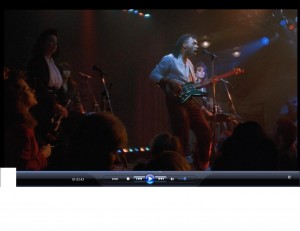 I saw James Ivory’s film Slaves of New York soon after it appeared in 1989. The movie contains a scene set in a nightclub (minutes 63-69) with the most superb trance music, played by a male singer/guitarist and 3 female supporting musicians: one on percussion, one on synth, and a trumpeter. For most of this number, the trumpeter is smoking a cigarette, not playing, until near the end, when she plays while holding her smoking cigarette. The rhythm is a consistent, driving pattern: ta-ta-ta-ta daa daa (eg, 4 quavers followed by two crotchets) in each bar, or variants of this, with no changes of harmony, and drone-like chants over the top. The percussion includes a regular high-pitched woodblock (or similar).
I saw James Ivory’s film Slaves of New York soon after it appeared in 1989. The movie contains a scene set in a nightclub (minutes 63-69) with the most superb trance music, played by a male singer/guitarist and 3 female supporting musicians: one on percussion, one on synth, and a trumpeter. For most of this number, the trumpeter is smoking a cigarette, not playing, until near the end, when she plays while holding her smoking cigarette. The rhythm is a consistent, driving pattern: ta-ta-ta-ta daa daa (eg, 4 quavers followed by two crotchets) in each bar, or variants of this, with no changes of harmony, and drone-like chants over the top. The percussion includes a regular high-pitched woodblock (or similar).
Other than two songs by the combo of Arto Lindsay and Peter Scherer, this is the best music in the film (which apart from this music is forgettable). Unfortunately, this track is not on the official soundtrack, and the credits at the end of the film do not identify it clearly. The song is Mother Dearest, and the male singer (and the song’s composer) is Joe Leeway, formerly of British group, The Thompson Twins. It is a shame that he has not released any music under his own name, and no longer seems to be working as a muso. What a great loss to music.
Monthly Archives: January 2014
Page 2 of 2
Go West, young man
I was headed out down a long bone-white road, straight as a string and smooth as glass and glittering and wavering in the heat and humming under the tires like a plucked nerve. I was doing seventy-five but I never seemed to catch up with the pool that seemed to be over the road just this side of the horizon. Then, after a while, the sun was in my eyes, for I was driving west. So I pulled the sun screen down and squinted and put the throttle to the floor. And kept on moving west. For West is where we all plan to go someday. It is where you go when the land gives out and the old-field pines encroach. It is where you go when you get the letter saying: ‘Flee, all is discovered.’ It is where you go when you look down at the blade in your hand and see the blood on it. It is where you go when you are told that you are a bubble on the tide of empire. It is where you go to grow up with the country. It is where you go to spend your old age. Or it is just where you go.
It was just where I went.”
Robert Penn Warren [1946]: All the King’s Men. Harcourt, Brace and Company.
Transitions 2013
People who have passed on during 2013 whose life or works have influenced me:
- Joan Child (1921-2013), Australian politician, Speaker of the House of Representatives, Commonwealth of Australia
- Molly Clutton-Brock (1912-2013), British/Zimbabwean community organizer and anti-racism campaigner
- Peter Geach (1916-2013), British philosopher and logician
- Norman Geras (1943-2013), Zimbabwean/British political philosopher and blogger
- Natalia Gorbanevskaya (1936-2013), Russian/Polish poet and political activist
- Michael Heath (1956-2013), American USNavy SEAL and businessman
- Fr Stan Hosie (1922-2013), Australian/American priest, teacher, swimming coach, life member of the Far North Coast Amateur Swimming Association, and co-founder of the third-world development charity Counterpart International
- Doris Lessing (1919-2013), Zimbabwean/British writer and political activist
- John Makumbe (1949-2013), Zimbabwean political scientist and democracy activist
- Nelson Mandela (1918-2013), South African freedom fighter and political leader
- Teresa Toranska (1944-2013), Polish journalist and writer.
Last year’s post is here.
Dissident graffiti in Czechoslovakia

In August 1984, I saw a display of cartoons by Jan Bernat, at the Mustek Metro Station in Prague, CSSR. One cartoon showed a crowd of Western Europeans of various nationalities saying “No”, “Non”, “Nien”, etc, to nuclear weapons, with Ronald Reagan in front of them all and holding a placard saying “YES.”
However, some graffitist had scribbled over Reagan’s “YES” and written “NO.”
Courage and luck
A dialog from Nadine Gordimer’s novel, A Guest of Honour (page 222):
‘Why does playing safe always seem to turn out to be so dangerous?’
‘It’s unlucky . . .
. . . because you’re too scared to take a chance.’
‘It’s unlucky to lack courage?’
‘That’s it. You have to go ahead into what’s coming, trust to luck. Because if you play safe you don’t have any, anyway.’
‘It’s forfeited?’
‘Yes.’
42 again
Following my recent post on the meaning of life, I recalled Georges Perec’s great novel, Life: A User’s Manual, which I first encountered in a 1987 book review by Paul Auster in the New York Times, here.
If anyone can be called the central character in this shifting, kaleidoscopic work, it would have to be Percival Bartlebooth, an eccentric English millionaire whose insane and useless 50-year project serves as an emblem for the book as a whole. Realizing as a young man that his wealth has doomed him to a life of boredom, Bartlebooth undertakes to study the art of watercolor with Serge Valene for a period of 10 years. Although he has no aptitude whatsoever for painting, he eventually reaches a satisfactory level of competence. Then, in the company of a servant, he sets out on a 20-year voyage around the world with the sole intention of painting watercolors of 500 different harbors and seaports.
As soon as one of these pictures is finished, he sends it to a man in Paris by the name of Gaspard Winckler, who also lives in the building. Winckler is an expert puzzle-maker whom Bartlebooth has hired to turn the watercolors into 750-piece jigsaw puzzles. One by one, the puzzles are made and stored in wooden boxes. When Bartlebooth returns from his travels and settles back into his apartment, he will methodically go about putting the puzzles together in chronological order. By means of an elaborate chemical process, the borders of the puzzle pieces have been glued together in such a way that the seams are no longer visible, thus restoring the watercolor to its original integrity. The painting, good as new, can then be removed from its wooden backing and sent to the place where it was originally executed. There it will be dipped into a detergent solution that eliminates all traces of the painting, yielding a clean and unmarked sheet of paper.
In other words, Bartlebooth will be left with nothing, the same thing he started with.
The idea of wasting the second half of your life trying to make sense of all you did in the first half I have found to be increasingly insightful as I age.
FWIW, Auster’s 1987 review appears to have been plagiarized, without any acknowledgement, in this 1999 post.
